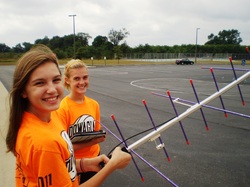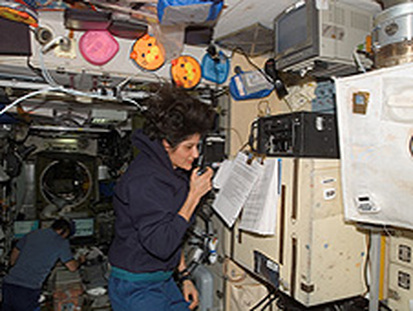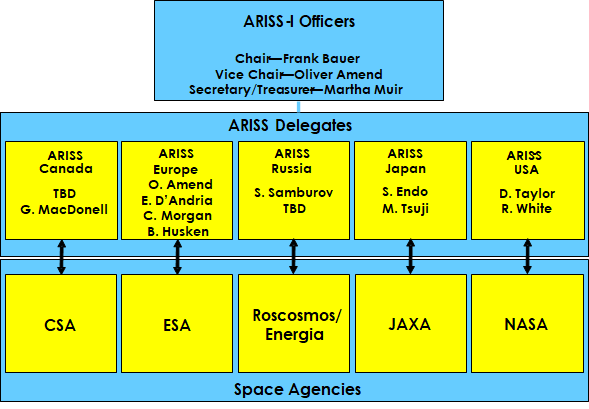Amateur Radio on the International Space Station (ARISS) inspires students, worldwide, to pursue interests and careers in science, technology, engineering and math through amateur radio communications opportunities with the International Space Station (ISS) on-orbit crew. Students learn about life on board the ISS and explore Earth from space through science and math activities. ARISS provides opportunities for the school community (students, teachers, families and community members) to become more aware of the substantial benefits of human spaceflight and the exploration and discovery that occur on spaceflight journeys. Students have the opportunity to learn about space technologies and the technologies involved with space communications through exploration of amateur radio.
Amateur Radio organizations, and space agencies in the USA, Russia, Canada, Japan and Europe sponsor this educational opportunity by providing the equipment and operational support to enable direct communication between crew on the ISS and students around the world via Amateur Radio. Hundreds of Amateur Radio operators around the world work behind the scenes to make these educational experiences possible. Amateur Radio is a popular hobby and a service in which licensed participants operate communications equipment with a deep appreciation of the radio art.
ARISS was created and is managed by an international working group, including several countries in Europe as well as Japan, Russia, Canada, and the USA. The organization is run by volunteers from the national amateur radio organizations and the international AMSAT (Radio Amateur Satellite Corporation) organizations from each country. Since ARISS is international in scope, the team coordinates locally with their respective space agency and as an international team through ARISS working group meetings, teleconferences and webinars.
Amateur Radio organizations, and space agencies in the USA, Russia, Canada, Japan and Europe sponsor this educational opportunity by providing the equipment and operational support to enable direct communication between crew on the ISS and students around the world via Amateur Radio. Hundreds of Amateur Radio operators around the world work behind the scenes to make these educational experiences possible. Amateur Radio is a popular hobby and a service in which licensed participants operate communications equipment with a deep appreciation of the radio art.
ARISS was created and is managed by an international working group, including several countries in Europe as well as Japan, Russia, Canada, and the USA. The organization is run by volunteers from the national amateur radio organizations and the international AMSAT (Radio Amateur Satellite Corporation) organizations from each country. Since ARISS is international in scope, the team coordinates locally with their respective space agency and as an international team through ARISS working group meetings, teleconferences and webinars.
For information provided by ARISS regional amateur radio partners and in other languages: Other ARISS Websites
Goals of the ARISS Program
- Inspire an interest in science, technology, engineering and math (STEM) subjects and in STEM careers among young people;
- Provide an educational opportunity for students, teachers and the general public to learn about space exploration, space technologies and satellite communications;
- Provide an educational opportunity for students, teachers and the general public to learn about wireless technology and radio science through Amateur Radio
- Provide an opportunity for Amateur Radio experimentation and evaluation of new technologies.
- Provide a contingency communications system for NASA and the ISS crew.
- Provide crew with another means to directly interact with a larger community outside the ISS, including friends and family.
History
Amateur radio was first used on the Space Shuttle to communicate from space to Earth in 1983. The Shuttle Amateur Radio Experiment (SAREX) was the forerunner of the ARISS program. Read more
Amateur radio was first used on the Space Shuttle to communicate from space to Earth in 1983. The Shuttle Amateur Radio Experiment (SAREX) was the forerunner of the ARISS program. Read more
ARISS Organization
ARISS is an international working group, consisting of delegations from 15 countries including several countries in Europe as well as Japan, Russia, Canada, and the USA. The organization is run almost entirely by volunteers from the national amateur radio organizations (e.g. the American Radio Relay League or ARRL in the U.S.) and the international AMSAT (Radio Amateur Satellite Corporation) organizations (e.g. AMSAT-NA in North America). Since ARISS is international in scope, the team coordinates locally with their respective space agency - the Canadian Space Agency (CSA), the European Space Agency (ESA), the Japan Aerospace Exploration Agency (JAXA), the Russian Space Agency (Roscosmos) and the National Aeronautics and Space Administration (NASA). Globally, ARISS-International coordinates as a team through working group meetings, teleconferences and electronic mail. ARISS-International consists of five regions (Canada, Europe, Japan, Russia and the U.S.) which parallel the five ISS space agencies. The ARISS-International Board includes the following officers: Chair, Vice-Chair and Secretary/Treasurer. Each region has two voting delegates except Europe, which has four delegates due to the many countries and regional space organizations that comprise Europe. These delegates are chosen from the national amateur radio societies and AMSAT organizations. Delegates are the designated points of contact for each ARISS region. Because parts of the world are not aligned to a specific ARISS region, augmentations to the regions are as follows:
- ARISS-Canada includes the Americas, except USA
- ARISS-Europe includes Africa, Middle East and Northern Asia
- ARISS-Japan includes Asia, Pacific and Australia
- ARISS-Russia
- ARISS-USA
The international team donates approximately $5 million per year of in-kind support to the ISS program, primarily through technical and educational volunteer support to the schools, flight hardware development, and contact operations support. In the U.S., the primary ARISS sponsors are NASA’s Space Communication and Navigation (SCaN) organization and the Center for the Advancement of Science in Space (CASIS). They provide financial support to fund the cost of ARISS operations support in Houston, which permits contact scheduling, crew training and crew ham radio licensing.
ARISS-International organization consists of five regions (Canada, Europe, Russia, Japan and the U.S.) paralleling the five ISS space agencies.
International Amateur Radio Union (IARU) societies and Radio Amateur Satellite Corporation (AMSAT) organizations participating in ARISS:
Space agencies partnering with ARISS:
-
Europe:
- Belgium: Union Royale Belge Des Amateurs-Emetteurs (UBA), AMSAT-Belgium
- France: Reseau des Emetteurs Francais (REF-Union), AMSAT Francophone
- Germany: Deutscher Amateur Radio Club e. V. (DARC)
- Italy: Associazione Radioamatori Italioni (ARI), AMSAT-Italia
- Netherlands: Vereniging voor Experimenteel Radio Onderzoek in Nederland VERON
- Poland: Polski Związek Krótkofalowców (PZK)
- Portugal: Rede dos Emissores Portugueses (REP)
- Sweden: AMSAT-SM
- Switzerland: Union Schweizerisscher Kurzwellen-Amateure USKA
- United Kingdom: Radio Society of Great Britain RSGB, AMSAT-UK
- Japan: Japan Amateur Radio League (JARL), JAMSAT
- Russia: Soyuz Radioljubitelei Rossii (SRR), AMSAT-RU
- USA: American Radio Relay League (ARRL), AMSAT-NA
Space agencies partnering with ARISS:
- Canada: Canadian Space Agency (CSA)
-
Europe: European Space Agency (ESA), including participating members:
- Belgium: Belgian Federal Science Policy Office (BSPO)
- Denmark: Danish National Space Center (DNSC)
- France: Centre national d'études spatiales / National Centre for Space Studies ( CNES)
- Germany: Deutsches Zentrum für Luft- und Raumfahrt (DLR)
- Italy: Agenzia Spaziale Italiana / The Italian Space Agency (ASI)
- Netherlands: Netherlands Space Office (NSO)
- Norway: Norwegian Space Centre (NSC)
- Spain: Centre for the Development of Industrial Technology (CDTI)
- Sweden: Swedish National Space Board (SNSB)
- Switzerland: State Secretariat for Education and Research (SERI)
- United Kingdom: UK Space Agency (UKSA)
- Japan: Japan Aerospace Exploration Agency (JAXA)
- Russia: Roscosmos State Corporation for Space Activities (Roscosmos)
- USA: National Aeronautics and Space Administration (NASA)
Extra Fields
General
-
Secure link?










Recommended Comments
There are no comments to display.
Please sign in to comment
You will be able to leave a comment after signing in
Sign In Now